University Essay: Gender Differences and Workplace Evolution
VerifiedAdded on 2020/05/08
|5
|1107
|212
Essay
AI Summary
This essay delves into the critical issue of gender differences within the evolving workplace. It explores how societal influences and organizational practices contribute to these differences, impacting employee attitudes and commitment. The essay examines the role of gender stereotypes, employment laws, and the concept of organizational commitment in shaping workplace dynamics. It highlights how differing perspectives and potential misunderstandings between genders can lead to conflict. The essay also discusses the importance of reducing gender bias and fostering a respectful, inclusive environment where both men and women are valued. The author references relevant research to support the analysis, providing a comprehensive overview of the challenges and opportunities related to gender in the modern workplace.
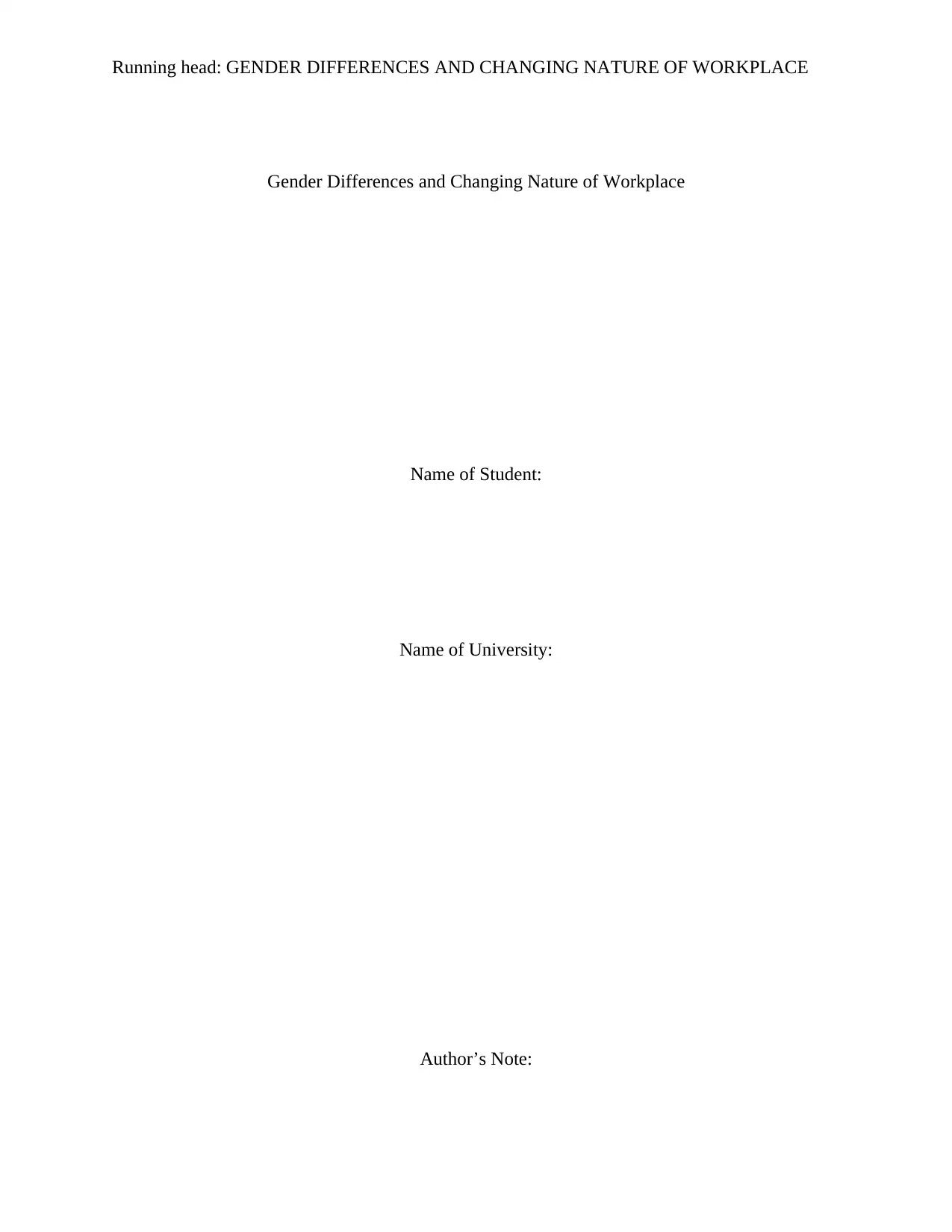
Running head: GENDER DIFFERENCES AND CHANGING NATURE OF WORKPLACE
Gender Differences and Changing Nature of Workplace
Name of Student:
Name of University:
Author’s Note:
Gender Differences and Changing Nature of Workplace
Name of Student:
Name of University:
Author’s Note:
Paraphrase This Document
Need a fresh take? Get an instant paraphrase of this document with our AI Paraphraser
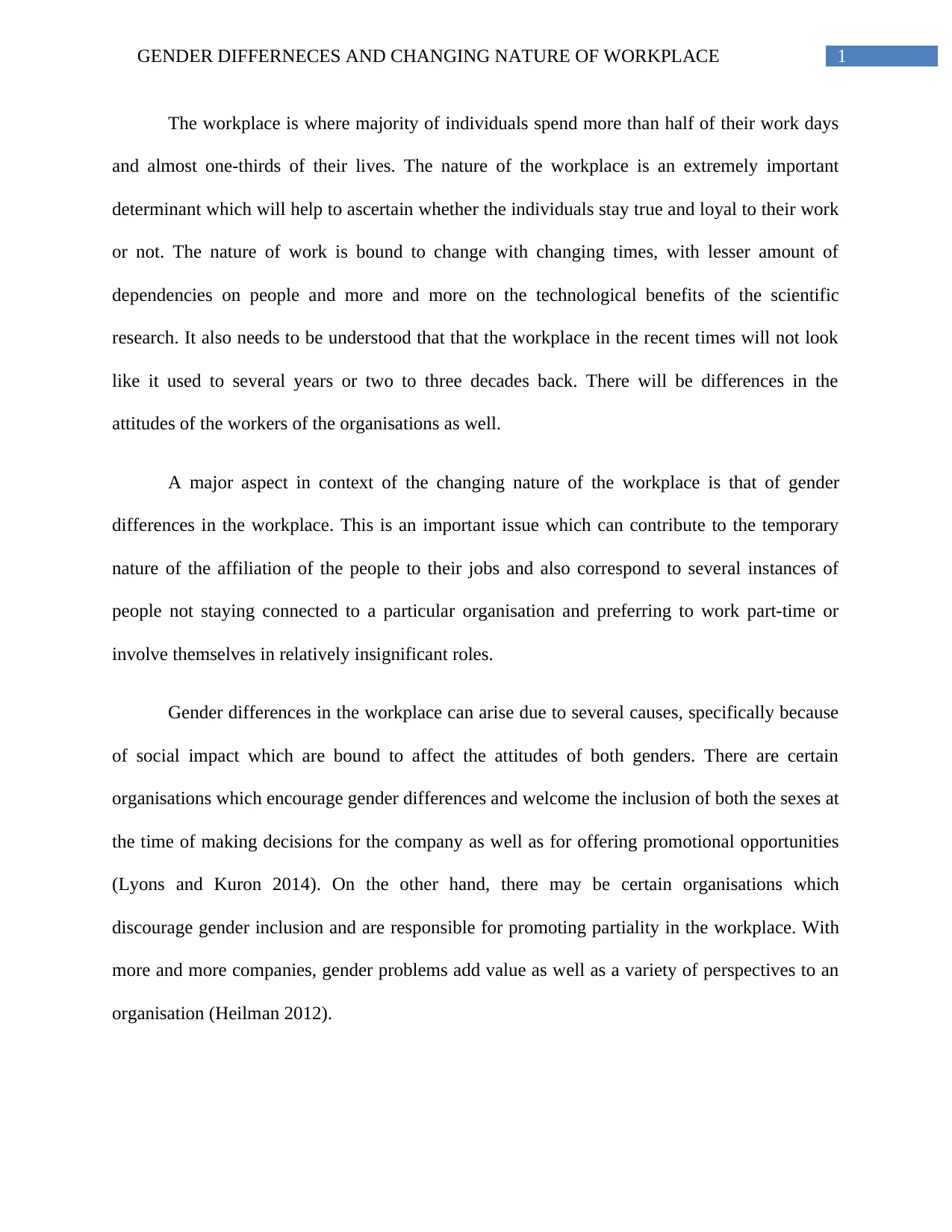
1GENDER DIFFERNECES AND CHANGING NATURE OF WORKPLACE
The workplace is where majority of individuals spend more than half of their work days
and almost one-thirds of their lives. The nature of the workplace is an extremely important
determinant which will help to ascertain whether the individuals stay true and loyal to their work
or not. The nature of work is bound to change with changing times, with lesser amount of
dependencies on people and more and more on the technological benefits of the scientific
research. It also needs to be understood that that the workplace in the recent times will not look
like it used to several years or two to three decades back. There will be differences in the
attitudes of the workers of the organisations as well.
A major aspect in context of the changing nature of the workplace is that of gender
differences in the workplace. This is an important issue which can contribute to the temporary
nature of the affiliation of the people to their jobs and also correspond to several instances of
people not staying connected to a particular organisation and preferring to work part-time or
involve themselves in relatively insignificant roles.
Gender differences in the workplace can arise due to several causes, specifically because
of social impact which are bound to affect the attitudes of both genders. There are certain
organisations which encourage gender differences and welcome the inclusion of both the sexes at
the time of making decisions for the company as well as for offering promotional opportunities
(Lyons and Kuron 2014). On the other hand, there may be certain organisations which
discourage gender inclusion and are responsible for promoting partiality in the workplace. With
more and more companies, gender problems add value as well as a variety of perspectives to an
organisation (Heilman 2012).
The workplace is where majority of individuals spend more than half of their work days
and almost one-thirds of their lives. The nature of the workplace is an extremely important
determinant which will help to ascertain whether the individuals stay true and loyal to their work
or not. The nature of work is bound to change with changing times, with lesser amount of
dependencies on people and more and more on the technological benefits of the scientific
research. It also needs to be understood that that the workplace in the recent times will not look
like it used to several years or two to three decades back. There will be differences in the
attitudes of the workers of the organisations as well.
A major aspect in context of the changing nature of the workplace is that of gender
differences in the workplace. This is an important issue which can contribute to the temporary
nature of the affiliation of the people to their jobs and also correspond to several instances of
people not staying connected to a particular organisation and preferring to work part-time or
involve themselves in relatively insignificant roles.
Gender differences in the workplace can arise due to several causes, specifically because
of social impact which are bound to affect the attitudes of both genders. There are certain
organisations which encourage gender differences and welcome the inclusion of both the sexes at
the time of making decisions for the company as well as for offering promotional opportunities
(Lyons and Kuron 2014). On the other hand, there may be certain organisations which
discourage gender inclusion and are responsible for promoting partiality in the workplace. With
more and more companies, gender problems add value as well as a variety of perspectives to an
organisation (Heilman 2012).
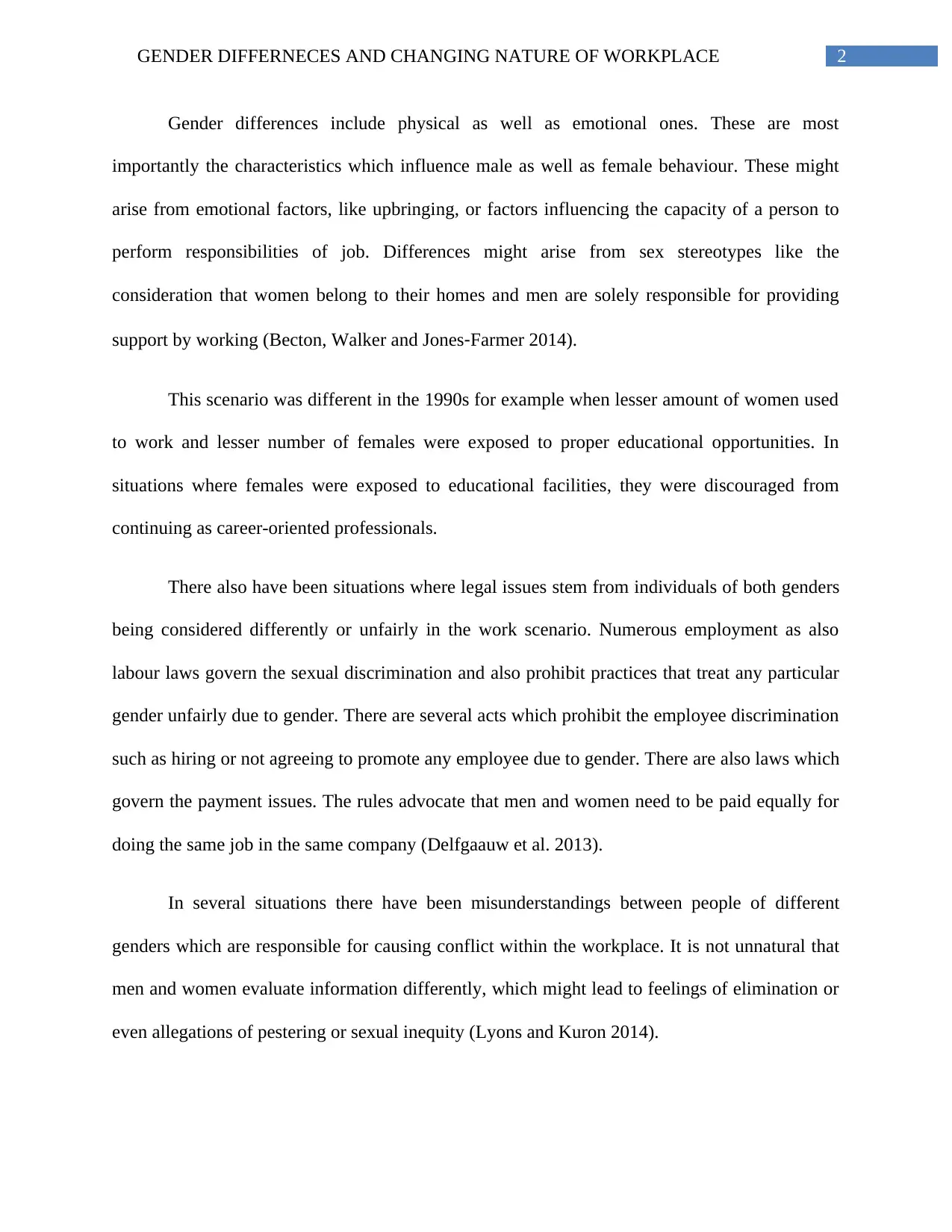
2GENDER DIFFERNECES AND CHANGING NATURE OF WORKPLACE
Gender differences include physical as well as emotional ones. These are most
importantly the characteristics which influence male as well as female behaviour. These might
arise from emotional factors, like upbringing, or factors influencing the capacity of a person to
perform responsibilities of job. Differences might arise from sex stereotypes like the
consideration that women belong to their homes and men are solely responsible for providing
support by working (Becton, Walker and Jones‐Farmer 2014).
This scenario was different in the 1990s for example when lesser amount of women used
to work and lesser number of females were exposed to proper educational opportunities. In
situations where females were exposed to educational facilities, they were discouraged from
continuing as career-oriented professionals.
There also have been situations where legal issues stem from individuals of both genders
being considered differently or unfairly in the work scenario. Numerous employment as also
labour laws govern the sexual discrimination and also prohibit practices that treat any particular
gender unfairly due to gender. There are several acts which prohibit the employee discrimination
such as hiring or not agreeing to promote any employee due to gender. There are also laws which
govern the payment issues. The rules advocate that men and women need to be paid equally for
doing the same job in the same company (Delfgaauw et al. 2013).
In several situations there have been misunderstandings between people of different
genders which are responsible for causing conflict within the workplace. It is not unnatural that
men and women evaluate information differently, which might lead to feelings of elimination or
even allegations of pestering or sexual inequity (Lyons and Kuron 2014).
Gender differences include physical as well as emotional ones. These are most
importantly the characteristics which influence male as well as female behaviour. These might
arise from emotional factors, like upbringing, or factors influencing the capacity of a person to
perform responsibilities of job. Differences might arise from sex stereotypes like the
consideration that women belong to their homes and men are solely responsible for providing
support by working (Becton, Walker and Jones‐Farmer 2014).
This scenario was different in the 1990s for example when lesser amount of women used
to work and lesser number of females were exposed to proper educational opportunities. In
situations where females were exposed to educational facilities, they were discouraged from
continuing as career-oriented professionals.
There also have been situations where legal issues stem from individuals of both genders
being considered differently or unfairly in the work scenario. Numerous employment as also
labour laws govern the sexual discrimination and also prohibit practices that treat any particular
gender unfairly due to gender. There are several acts which prohibit the employee discrimination
such as hiring or not agreeing to promote any employee due to gender. There are also laws which
govern the payment issues. The rules advocate that men and women need to be paid equally for
doing the same job in the same company (Delfgaauw et al. 2013).
In several situations there have been misunderstandings between people of different
genders which are responsible for causing conflict within the workplace. It is not unnatural that
men and women evaluate information differently, which might lead to feelings of elimination or
even allegations of pestering or sexual inequity (Lyons and Kuron 2014).
⊘ This is a preview!⊘
Do you want full access?
Subscribe today to unlock all pages.

Trusted by 1+ million students worldwide
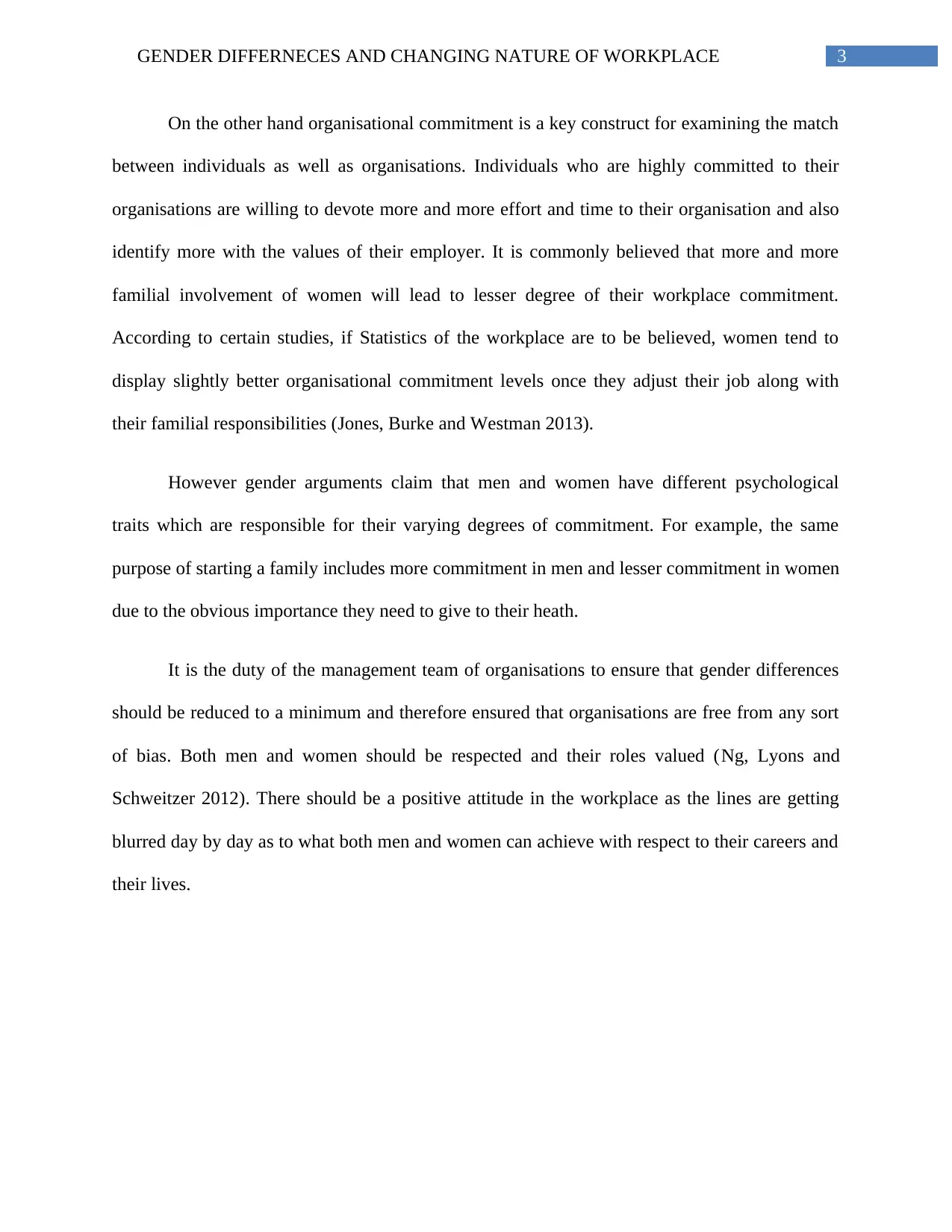
3GENDER DIFFERNECES AND CHANGING NATURE OF WORKPLACE
On the other hand organisational commitment is a key construct for examining the match
between individuals as well as organisations. Individuals who are highly committed to their
organisations are willing to devote more and more effort and time to their organisation and also
identify more with the values of their employer. It is commonly believed that more and more
familial involvement of women will lead to lesser degree of their workplace commitment.
According to certain studies, if Statistics of the workplace are to be believed, women tend to
display slightly better organisational commitment levels once they adjust their job along with
their familial responsibilities (Jones, Burke and Westman 2013).
However gender arguments claim that men and women have different psychological
traits which are responsible for their varying degrees of commitment. For example, the same
purpose of starting a family includes more commitment in men and lesser commitment in women
due to the obvious importance they need to give to their heath.
It is the duty of the management team of organisations to ensure that gender differences
should be reduced to a minimum and therefore ensured that organisations are free from any sort
of bias. Both men and women should be respected and their roles valued (Ng, Lyons and
Schweitzer 2012). There should be a positive attitude in the workplace as the lines are getting
blurred day by day as to what both men and women can achieve with respect to their careers and
their lives.
On the other hand organisational commitment is a key construct for examining the match
between individuals as well as organisations. Individuals who are highly committed to their
organisations are willing to devote more and more effort and time to their organisation and also
identify more with the values of their employer. It is commonly believed that more and more
familial involvement of women will lead to lesser degree of their workplace commitment.
According to certain studies, if Statistics of the workplace are to be believed, women tend to
display slightly better organisational commitment levels once they adjust their job along with
their familial responsibilities (Jones, Burke and Westman 2013).
However gender arguments claim that men and women have different psychological
traits which are responsible for their varying degrees of commitment. For example, the same
purpose of starting a family includes more commitment in men and lesser commitment in women
due to the obvious importance they need to give to their heath.
It is the duty of the management team of organisations to ensure that gender differences
should be reduced to a minimum and therefore ensured that organisations are free from any sort
of bias. Both men and women should be respected and their roles valued (Ng, Lyons and
Schweitzer 2012). There should be a positive attitude in the workplace as the lines are getting
blurred day by day as to what both men and women can achieve with respect to their careers and
their lives.
Paraphrase This Document
Need a fresh take? Get an instant paraphrase of this document with our AI Paraphraser
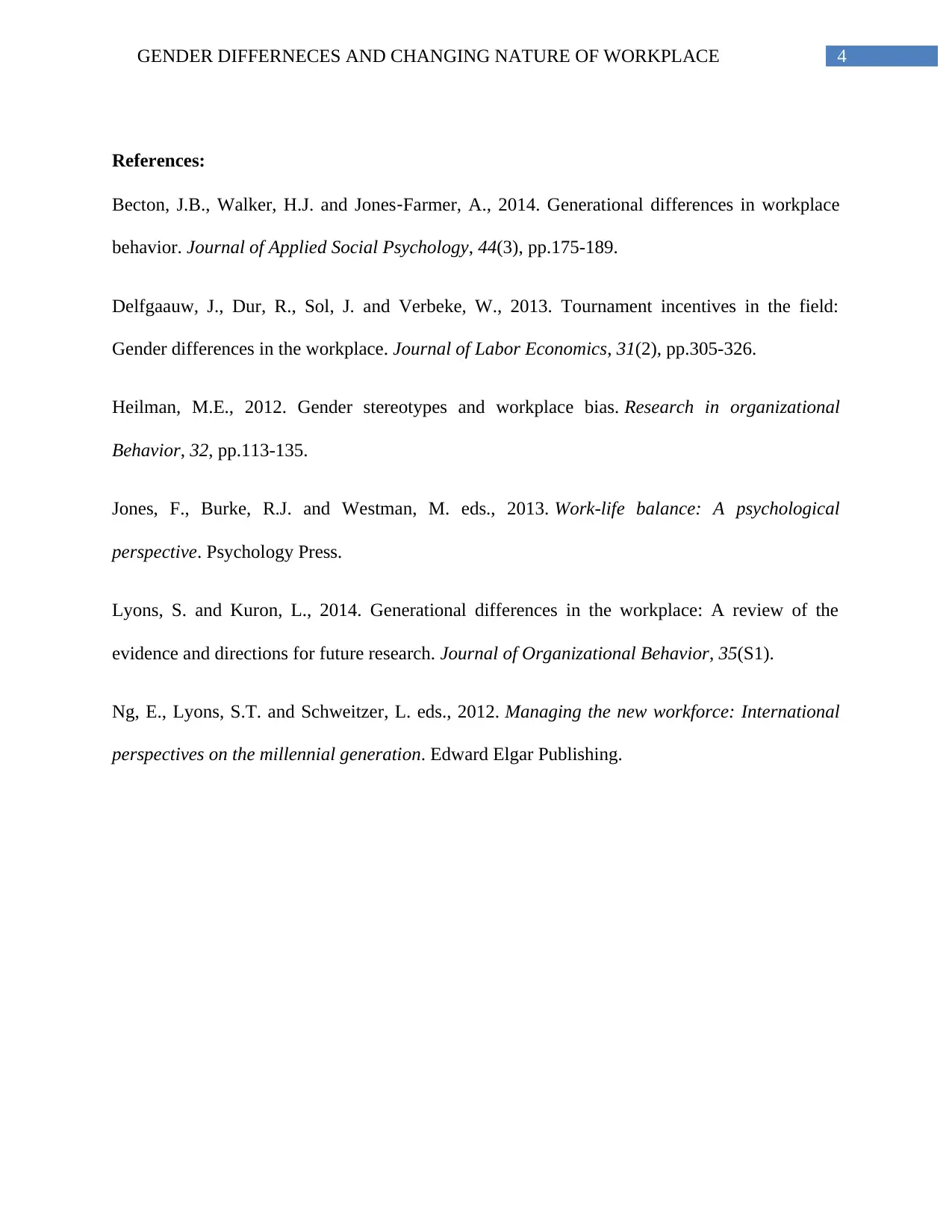
4GENDER DIFFERNECES AND CHANGING NATURE OF WORKPLACE
References:
Becton, J.B., Walker, H.J. and Jones‐Farmer, A., 2014. Generational differences in workplace
behavior. Journal of Applied Social Psychology, 44(3), pp.175-189.
Delfgaauw, J., Dur, R., Sol, J. and Verbeke, W., 2013. Tournament incentives in the field:
Gender differences in the workplace. Journal of Labor Economics, 31(2), pp.305-326.
Heilman, M.E., 2012. Gender stereotypes and workplace bias. Research in organizational
Behavior, 32, pp.113-135.
Jones, F., Burke, R.J. and Westman, M. eds., 2013. Work-life balance: A psychological
perspective. Psychology Press.
Lyons, S. and Kuron, L., 2014. Generational differences in the workplace: A review of the
evidence and directions for future research. Journal of Organizational Behavior, 35(S1).
Ng, E., Lyons, S.T. and Schweitzer, L. eds., 2012. Managing the new workforce: International
perspectives on the millennial generation. Edward Elgar Publishing.
References:
Becton, J.B., Walker, H.J. and Jones‐Farmer, A., 2014. Generational differences in workplace
behavior. Journal of Applied Social Psychology, 44(3), pp.175-189.
Delfgaauw, J., Dur, R., Sol, J. and Verbeke, W., 2013. Tournament incentives in the field:
Gender differences in the workplace. Journal of Labor Economics, 31(2), pp.305-326.
Heilman, M.E., 2012. Gender stereotypes and workplace bias. Research in organizational
Behavior, 32, pp.113-135.
Jones, F., Burke, R.J. and Westman, M. eds., 2013. Work-life balance: A psychological
perspective. Psychology Press.
Lyons, S. and Kuron, L., 2014. Generational differences in the workplace: A review of the
evidence and directions for future research. Journal of Organizational Behavior, 35(S1).
Ng, E., Lyons, S.T. and Schweitzer, L. eds., 2012. Managing the new workforce: International
perspectives on the millennial generation. Edward Elgar Publishing.
1 out of 5
Related Documents
Your All-in-One AI-Powered Toolkit for Academic Success.
+13062052269
info@desklib.com
Available 24*7 on WhatsApp / Email
![[object Object]](/_next/static/media/star-bottom.7253800d.svg)
Unlock your academic potential
Copyright © 2020–2025 A2Z Services. All Rights Reserved. Developed and managed by ZUCOL.





